Traditional sushi can be surprisingly high in carbs thanks to the white rice — but this low-carb sushi skips the rice and uses cauliflower instead, for a lighter, grain-free roll. Each serving delivers 35 g of protein, 8 g of fiber, and a powerhouse of micronutrients — all for just 400 calories. It’s simple to make, nutrient-dense, and just as satisfying to eat as the real thing.
Why Cauliflower Rice Works So Well
Cauliflower has had its moment (and it’s still going strong) — it can become pizza crust, gnocchi, even brownies. So why not sushi rice? Some people will tell you that frozen cauliflower rice won’t work, but I respectfully disagree. While I love cooking from scratch, I don’t think anyone needs to grate cauliflower by hand just to make sushi rolls (it makes such a mess!).
If you can find fresh cauliflower rice, great. If not, frozen works perfectly — just thaw it first (overnight in the fridge or a few hours at room temperature) and drain it well on paper towels to remove excess moisture. The rest of the moisture will evaporate as it cooks, leaving you with perfectly cooked (al dente), fluffy, non-soggy rice.
The Filling – Shrimp or Crab
For the filling, I keep it simple with cooked wild-caught shrimp, which I buy frozen, peeled, and deveined. Wild-caught shrimps here in Denmark are pretty small, but any size would work, as they need to be chopped, anyway. Just make sure to thaw completely and pat them dry to remove any extra water before chopping and mixing with mayo.
You can also swap shrimp for crab meat (the real one!), or use a combination of both for a more classic “California roll” feel. When I lived in Dallas, crab was one of my favorite proteins to buy, but here in Denmark it’s a little harder to find — so shrimp it is!
If you have a good-quality avocado oil mayonnaise on hand, that works perfectly, or you can make your own healthy mayonnaise in about five minutes.
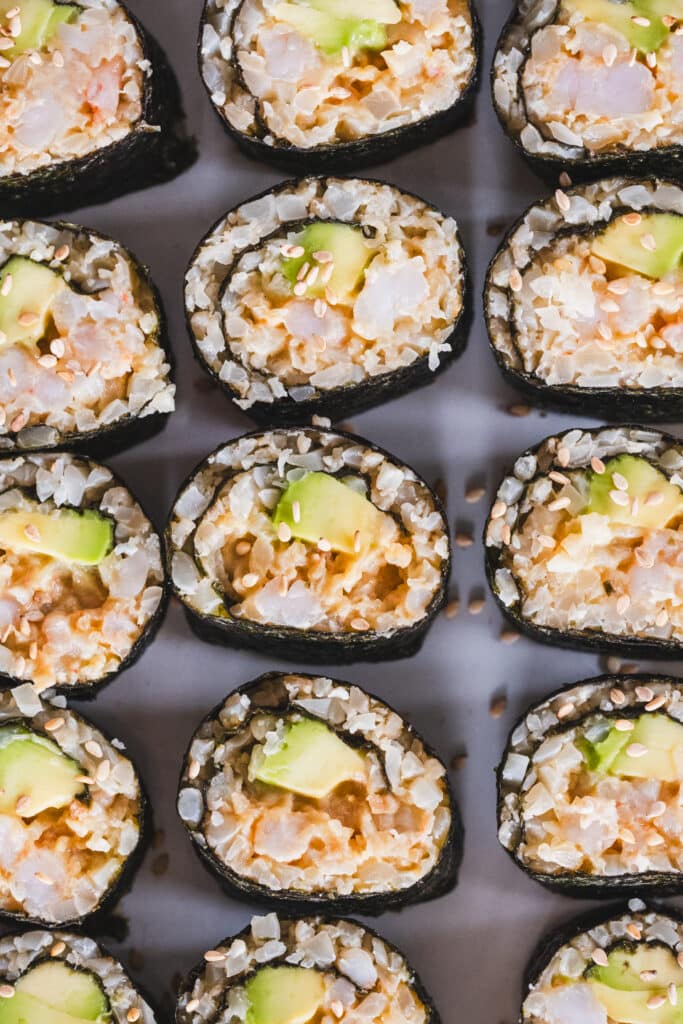
Rolling Your Sushi
This is the only part that might feel a little intimidating at first, but trust me — it’s easier than it looks. I highly recommend getting a sushi rolling mat and watching a quick video tutorial before you start, just to get the basics down. Once you’ve tried it once, it becomes second nature (and honestly, a little addictive).
Soy or No Soy?
In my kitchen, I use coconut aminos as my soy sauce replacement — it’s naturally gluten-free and has a lovely, slightly sweet flavor. Tamari is my second choice, but look for a good-quality Japanese version that’s naturally gluten-free (always double-check the label). Either will work beautifully in this recipe.
Below, you’ll find the complete ingredient list and step-by-step instructions, with photos. For a printable recipe card and nutritional information, scroll down to the end of the post.
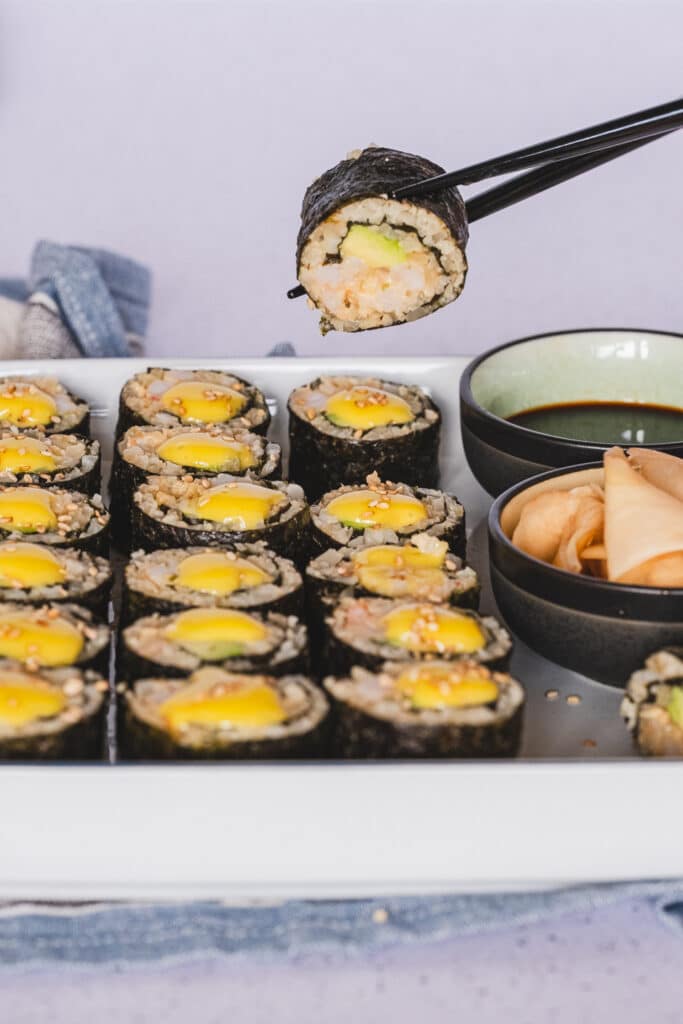
Ingredients to Make Low-Carb Sushi Rolls
For the cauliflower rice
- 350–400 g (about 3–4 cups) cauliflower rice (fresh or frozen)
- 1 tablespoon sesame oil
- 1 tablespoon coconut aminos
- 1 tablespoon rice vinegar
- 1 tablespoon allulose
For the shrimp filling
- 250 g cooked, deshelled wild-caught shrimp (any size)
- 2 tablespoons mayonnaise (avocado or olive oil mayo)
- A few drops of Tabasco or Sriracha (to taste)
- 1 teaspoon coconut aminos or gluten-free tamari
Tip: You can swap the shrimp for crab meat or use a mix of both.
For assembling and serving
- 3 toasted (ready-to-use) nori sheets
- 1 ripe avocado, thinly sliced
- Tamari or coconut aminos (for dipping)
- 1 tablespoon mayonnaise (for drizzling)
- Extra Tabasco or Sriracha (for spicy mayo)
- Wasabi paste
- Pickled ginger
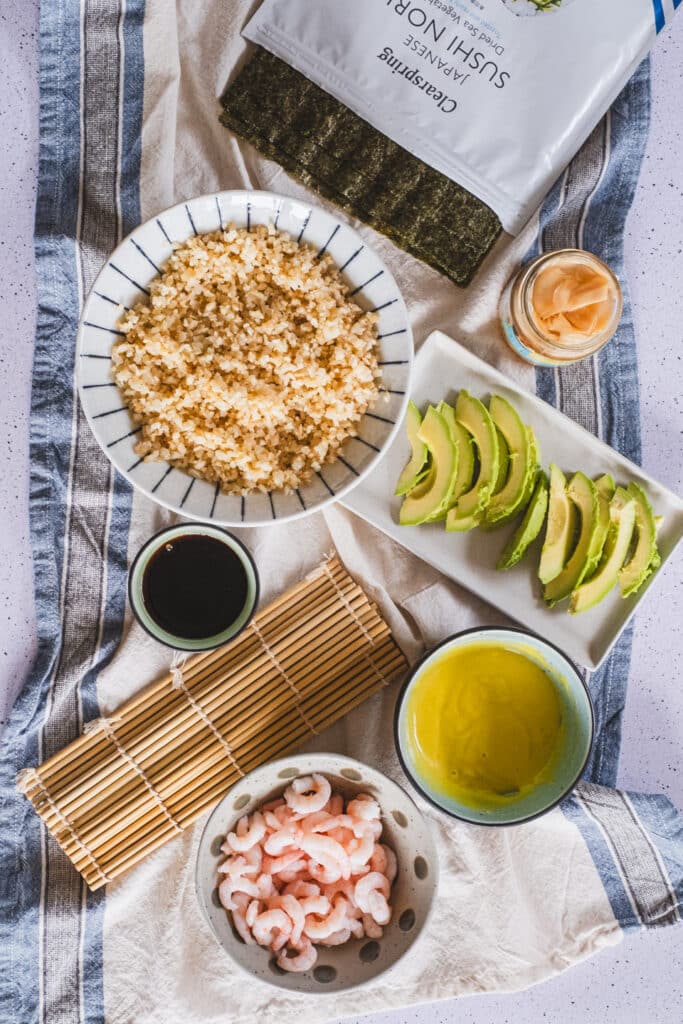
Step-by-Step Instructions
Prepare the cauliflower rice
- If using frozen cauliflower rice, thaw it first and drain well on paper towels to remove excess moisture.
- Heat a skillet over medium heat and add sesame oil.
- Add cauliflower rice and cook, stirring occasionally, for 5–8 minutes until softened and most moisture has evaporated.
- Stir in coconut aminos, rice vinegar, and allulose. Cook for another 1–2 minutes.
- Remove from heat and allow to cool completely, uncovered. (Warm rice will make the nori soggy.)
Make the shrimp filling
- Pat shrimp dry with paper towels.
- Chop them into small pieces, then mix with mayonnaise, coconut aminos, and hot sauce to taste.
- Set aside.
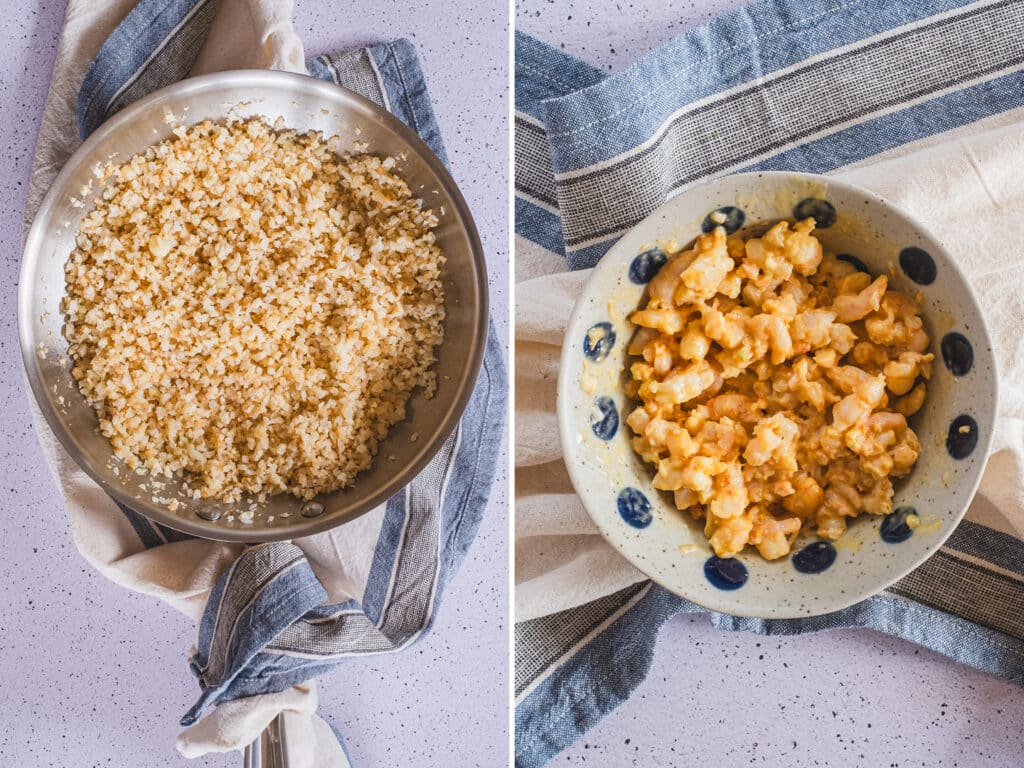
Set up your rolling station
- Wrap a sushi rolling mat in plastic wrap for easy cleanup.
- Place the nori sheet shiny side down on the mat (I line the stripes vertically, but either way works).
- Divide the cauliflower rice and shrimp filling into three equal portions.
Assemble and roll
Spread the rice – Gently spread 1/3 of the cauliflower rice evenly over the nori, leaving:
- 1–2 cm (about 1/2–1 inch) uncovered at the bottom edge (closest to you)
- 2–3 cm (about 1 inch) uncovered at the top edge (this helps seal the roll)
Add filling – Arrange 1/3 of the shrimp mixture in a horizontal strip across the rice, about 1 inch wide and roughly 1/3 of the way up from the bottom edge. Top with 3 slices of avocado.
Moisten the top edge – Dip your fingers in cold water and lightly wet the bare top edge of the nori (this acts as “glue”).
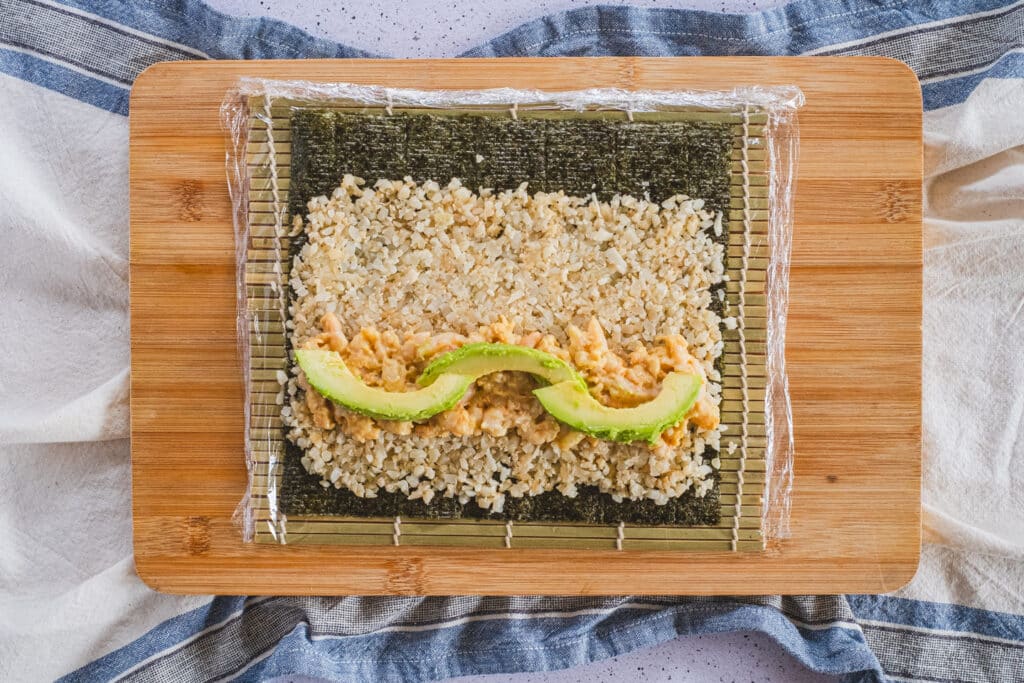
Roll tightly
Using the mat, lift the bottom edge of the nori up and over the filling.
Tuck it in gently but firmly so the roll is tight and compact.
Continue rolling forward, pulling the mat away as you go, until you reach the top edge and the roll is sealed.
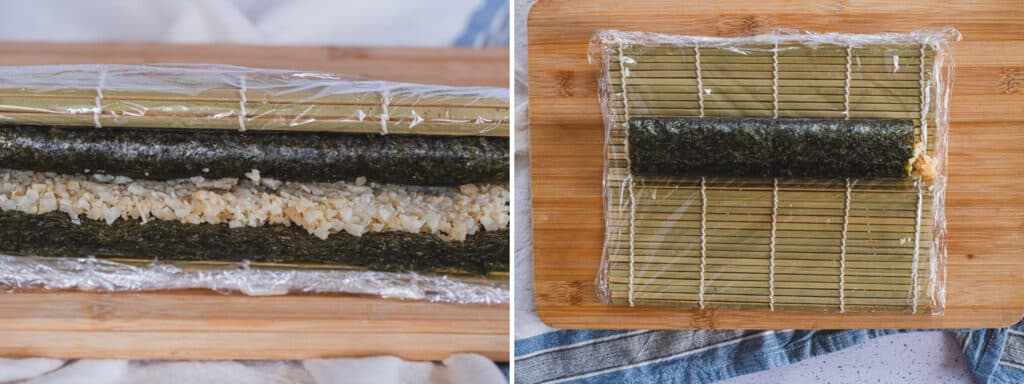
Repeat with the remaining two nori sheets and fillings.
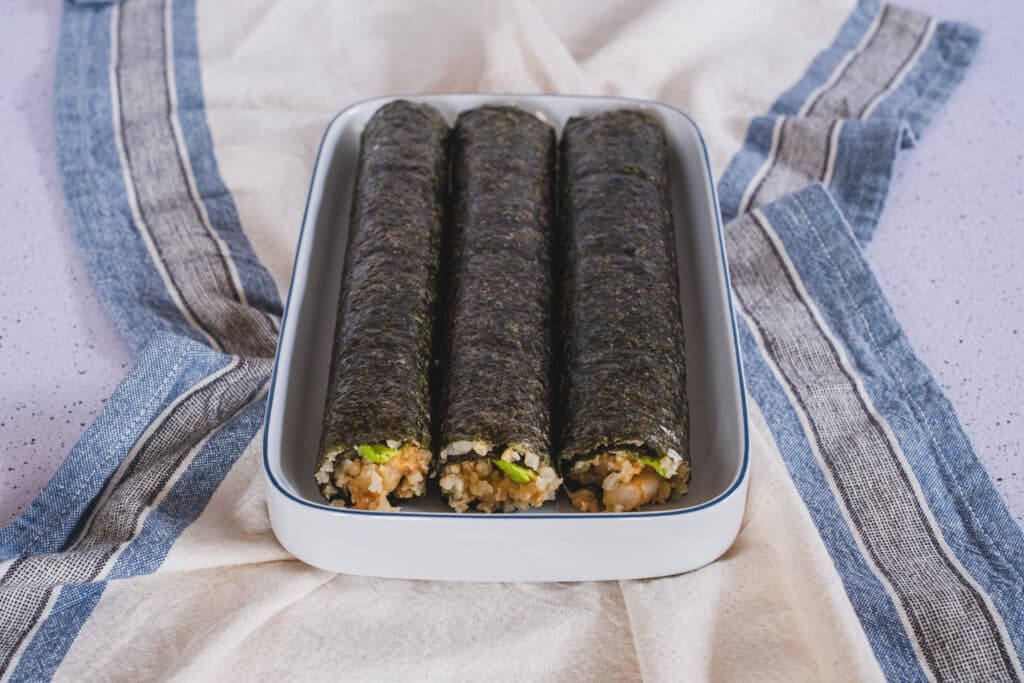
Slice and serve
Place each roll seam-side down on a cutting board. Using a very sharp knife, cut the roll in half, then cut each half into 3–4 even pieces.
Tip: Wet and wipe the knife after each cut to prevent sticking.
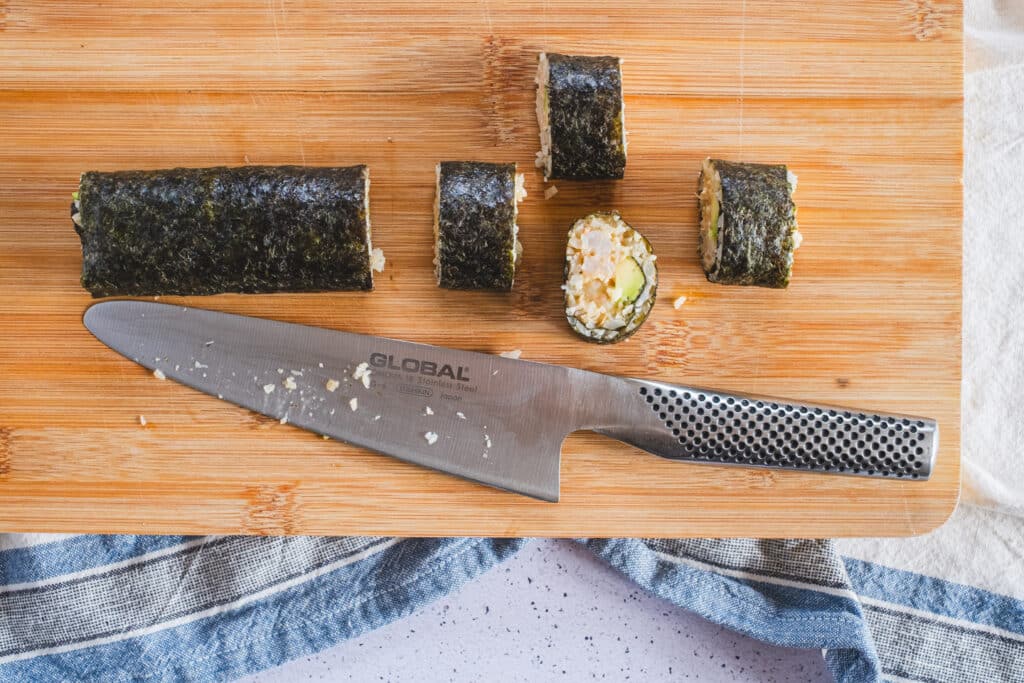
Arrange on a serving platter
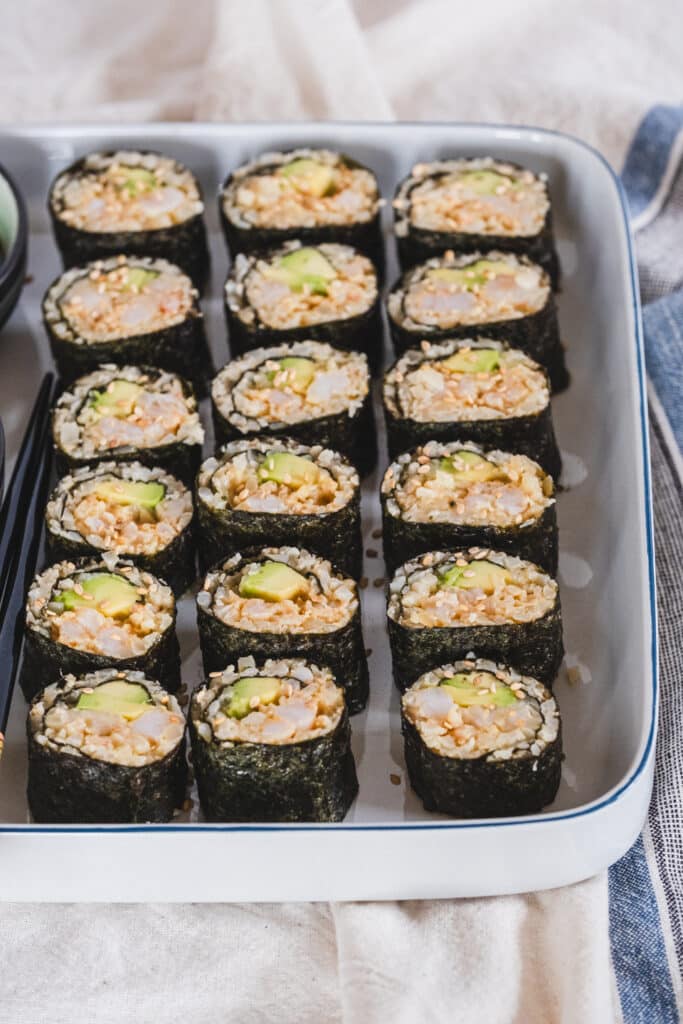
How to Serve Low-Carb Sushi Rolls
Once all the rolls are portioned, drizzle with spicy mayo (mayonnaise + Tabasco or Sriracha) if desired. Serve with gluten-free tamari or coconut aminos, wasabi, and pickled ginger. Dip each roll in the sauce before serving.
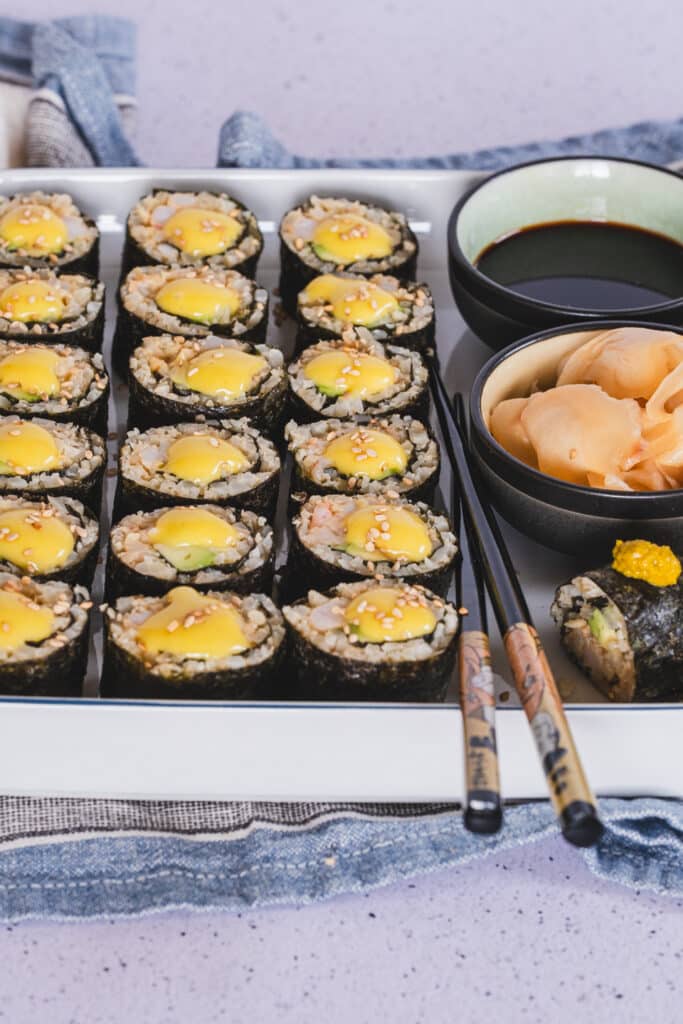
Enjoy!
Nori Chips
If you have leftover nori sheets and love nori as much as I do, try making nori chips at home. They are the most satisfying, nutritious, and low-carb snacks. Here is the recipe:
*This post contains affiliated links, which means I get a small commission if you choose to purchase something via one of my links, at no extra cost to you.
Print
Low-Carb Sushi Rolls with Cauliflower Rice
- Prep Time: 40 minutes
- Cook Time: 10 minutes
- Total Time: 50 minutes
- Yield: 2 servings
Description
Traditional sushi can be surprisingly high in carbs thanks to the white rice — but this low-carb sushi skips the rice and uses cauliflower instead, for a lighter, grain-free roll. Each serving delivers 35 g of protein, 8 g of fiber, and a powerhouse of micronutrients — all for just 400 calories. It’s simple to make, nutrient-dense, and just as satisfying to eat as the real thing.
Ingredients
FOR THE CAULIFLOWER RICE
- 350–400 g (about 3–4 cups) cauliflower rice (fresh or frozen)
- 1 tablespoon sesame oil
- 1 tablespoon coconut aminos
- 1 tablespoon rice vinegar
- 1 tablespoon allulose
FOR THE SHRIMP FILLING
- 250 g cooked, deshelled wild-caught shrimp (any size)
- 2 tablespoons mayonnaise (avocado or olive oil mayo)
- A few drops of Tabasco or Sriracha (to taste)
- 1 teaspoon coconut aminos or gluten-free tamari
FOR ASSEMBLING AND SERVING
- 3 toasted (ready-to-use) nori sheets
- 1 ripe avocado, thinly sliced
- Tamari or coconut aminos (for dipping)
- 1 tablespoon mayonnaise (for drizzling)
- Extra Tabasco or Sriracha (for spicy mayo)
- Wasabi paste (see notes)
- Pickled ginger
Instructions
PREPARE THE CAULIFLOWER RICE
- If using frozen cauliflower rice, thaw it first and drain well on paper towels to remove excess moisture.
- Heat a skillet over medium heat and add sesame oil.
- Add cauliflower rice and cook, stirring occasionally, for 5–8 minutes until softened and most moisture has evaporated.
- Stir in coconut aminos, rice vinegar, and allulose. Cook for another 1–2 minutes.
- Remove from heat and allow to cool completely, uncovered. (Warm rice will make the nori soggy.)
MAKE THE SHRIMP FILLING
- Pat shrimp dry with paper towels.
- Chop them into small pieces, then mix with mayonnaise, coconut aminos, and hot sauce to taste.
- Set aside.
SET UP YOUR ROLLING STATION
- Wrap a sushi rolling mat in plastic wrap for easy cleanup.
- Place the nori sheet shiny side down on the mat (I line the stripes vertically, but either way works).
- Divide the cauliflower rice and shrimp filling into three equal portions.
ASSEMBLE AND ROLL
- Spread the rice – Gently spread 1/3 of the cauliflower rice evenly over the nori, leaving:
- 1–2 cm (about 1/2–1 inch) uncovered at the bottom edge (closest to you)
- 2–3 cm (about 1 inch) uncovered at the top edge (this helps seal the roll)
- Add filling – Arrange 1/3 of the shrimp mixture in a horizontal strip across the rice, about 1 inch wide and roughly 1/3 of the way up from the bottom edge. Top with 3 slices of avocado.
- Moisten the top edge – Dip your fingers in cold water and lightly wet the bare top edge of the nori (this acts as “glue”).
ROLL TIGHTLY
- Using the mat, lift the bottom edge of the nori up and over the filling.
- Tuck it in gently but firmly so the roll is tight and compact.
- Continue rolling forward, pulling the mat away as you go, until you reach the top edge and the roll is sealed.
- Repeat with the remaining two nori sheets and fillings.
SLICE AND SERVE
- Place each roll seam-side down on a cutting board.
- Using a very sharp knife, cut the roll in half, then cut each half into 3–4 even pieces.
- Tip: Wet and wipe the knife after each cut to prevent sticking.
- Arrange on a serving platter and drizzle with spicy mayo if desired.
- Serve with tamari/coconut aminos, wasabi, and pickled ginger.
Notes
- The filling: You can swap the shrimp for crab meat or use a mix of both.
- Wasabi: Store-bought wasabi paste is often full of undesirable ingredients, so I recommend using pure wasabi powder and preparing the paste at home (follow the instructions on the package, which typically involve mixing wasabi powder with water).
- Rolling Sushi: This is the only part that might feel a little intimidating at first, but trust me — it’s easier than it looks. I highly recommend getting a sushi rolling mat and watching a quick video tutorial before you start, just to get the basics down. Some rolling mats also come with tutorials. Once you’ve tried it once, it becomes second nature.
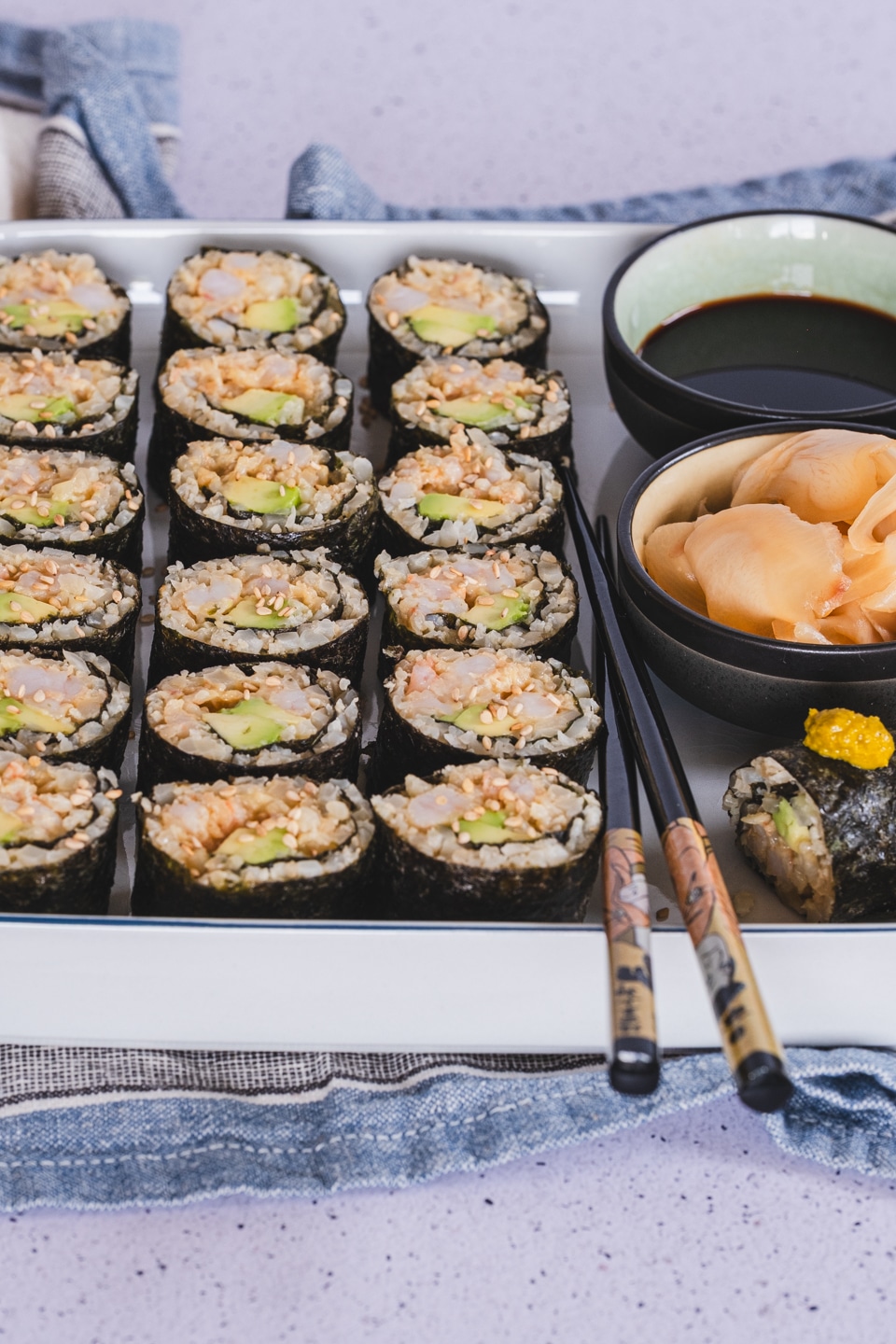

1 Comment
Christian
October 14, 2025 at 5:02 amThese low-carb sushi rolls are delicious and so much lighter than traditional sushi.